Elastomeric infusion pumps | Single-use infusion pumps
Elastomeric infusion pumps for single-use, work independently from external energy sources, and allow for safe and continuous application of medication in clinics and at home. The pumping effect is achieved by the positive pressure of the filled elastomeric balloon. The flow rate is regulated by a flow restrictor, integrated into the infusion line, so that programming by doctors or nursing staff is unnecessary.
Detailed information on the operating principle of elastomeric pumps
CareVis Single-Use Infusion Pump | Sovereign safety
The specifications for safety features that must be integrated in every pump are regulated in ISO 28620. This standard also describes the regulations for the accuracy of the flow rate and the permissible tolerances.CareVis elastomeric infusion pumps are characterised by a central, elastomeric balloon, protected by a hard and transparent case, with an easy to read flow indicator. They are equipped with numerous safety features, such as particle filters of 1.2 μm and ventilation filters of 0.2 μm as well as a kink-resistant line, and exceed the flow rate specifications of ISO 28620 with very precise flow rates.
Learn more about the safety of elastomeric pumps
Advantages of CareVis at a glance
No matter if outpatient or in-patient, in a hospital or other care facility, CareVis provides the benefit of unrestricted mobility, allowing patients to faster regain the moveability required in daily life.
- closed system for single-use for safe and easy handling
- high flow rate accuracy
- drop resistant case to protect the balloon reservoir from external influences
- axial guided balloon expansion for consistent basal flow
- non-kinking infusion line preventing a block of the drug administration
- easy to read indicator to monitor infusion progress
- minimal residual volume, for complete drug administration
- bacteria-proof air venting cap - priming with installed cap preventing drippage
- inline filter (1.2 µm particular filter, and 0.2 µm air filter, to reduce the risk of air embolism and particle contamination
- alarm, battery, and maintenance free
- small, easy and discreet for the patient
- free from latex and phthalate
Learn more about the advantages of elastomeric pumps
Financial advantages of elastomeric pumps
CareVis' high-quality but cost-effective elastomeric pumps can significantly reduce the cost per patient compared to mobile electric PCA pumps. Our analysis shows a clear cost advantage of elastomeric pumps over electric PCA pumps.
Learn more about the cost-saving potential of elastomeric pumps
CareVis Nax - Neuraxial connections according to ISO 80369-6
All CareVis models for continuous neuraxial, plexus and wound infiltration anesthesia are available under the name CareVis Nax with connections according to ISO 80369-6.
Product portfolio
Following the revision of the Neofuser elastomeric pump, Promecon is re-bundling its extensive portfolio of high-quality elastomeric pumps by the brand name CareVis. With our large range of CareVis elastomeric infusion pumps, we offer a safe alternative to electronic pump systems for use in diverse therapeutic fields and applications.
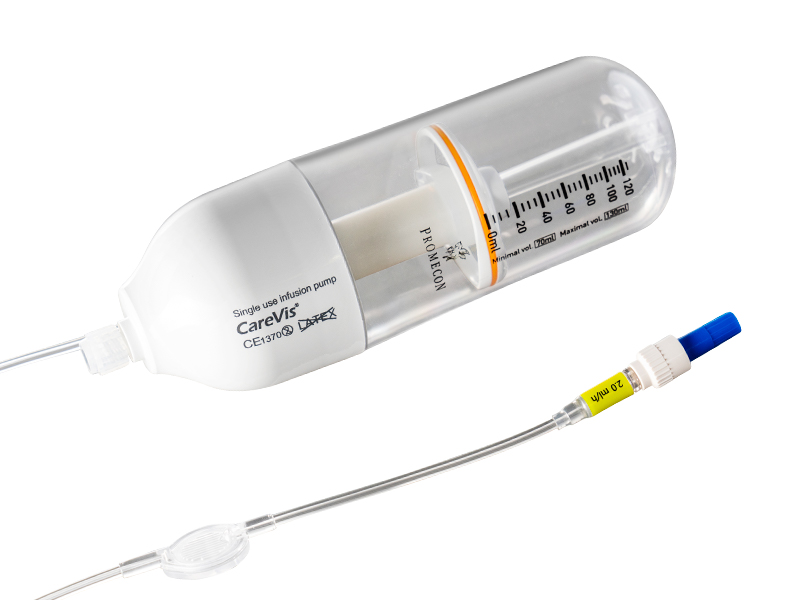
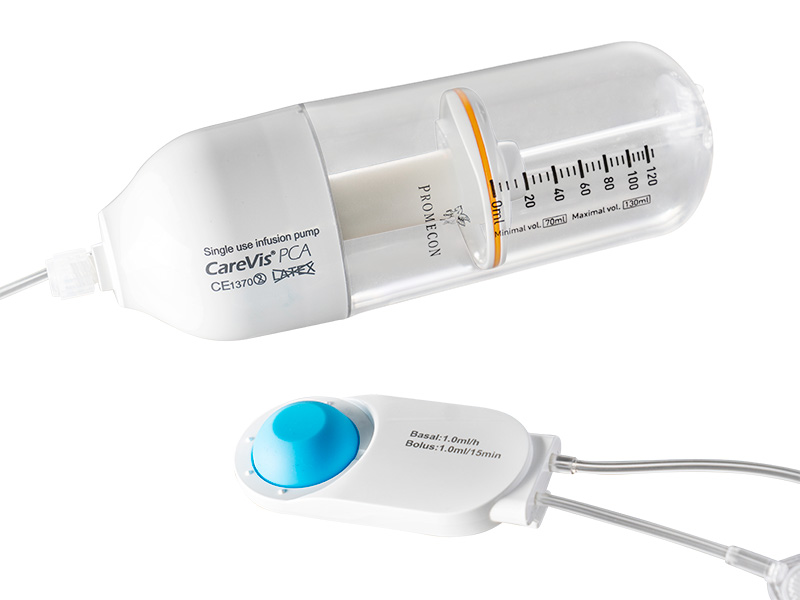
Single-use PCA pump with continuous basal flow and bolus function
Learn more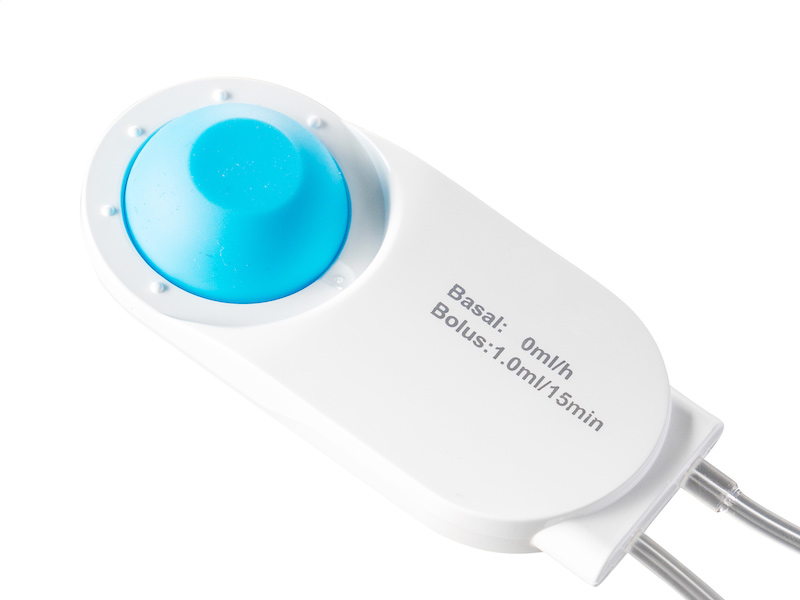
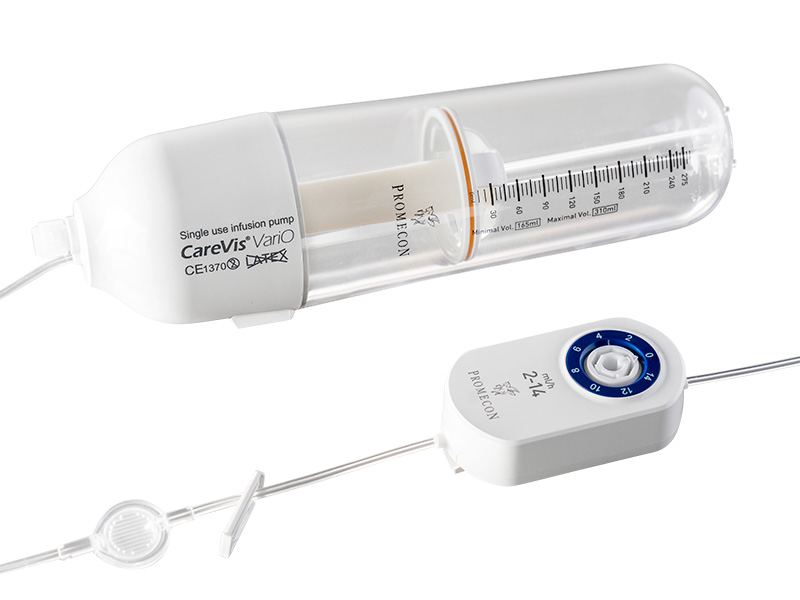
Single-use infusion pumps with selectable rate of basal flows
Learn more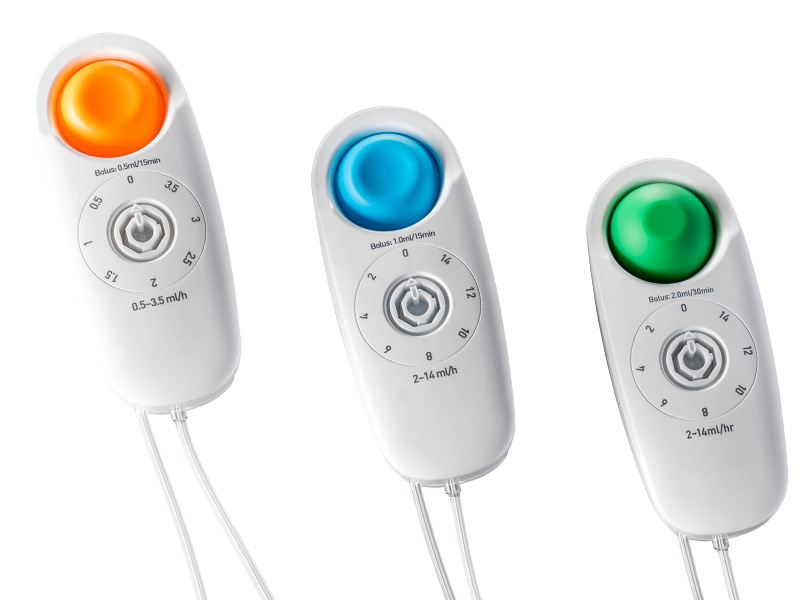
Single-use infusion pump with selectable basal rate supplemented by bolus function
Learn more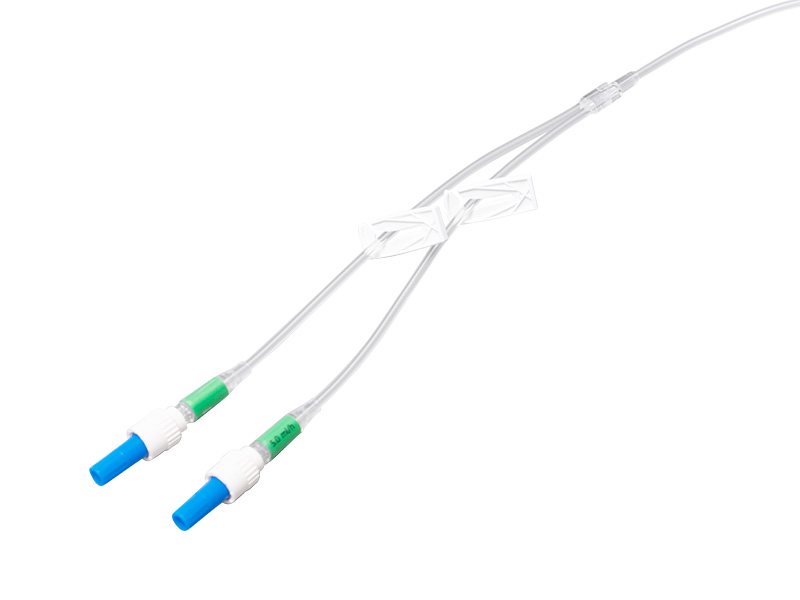
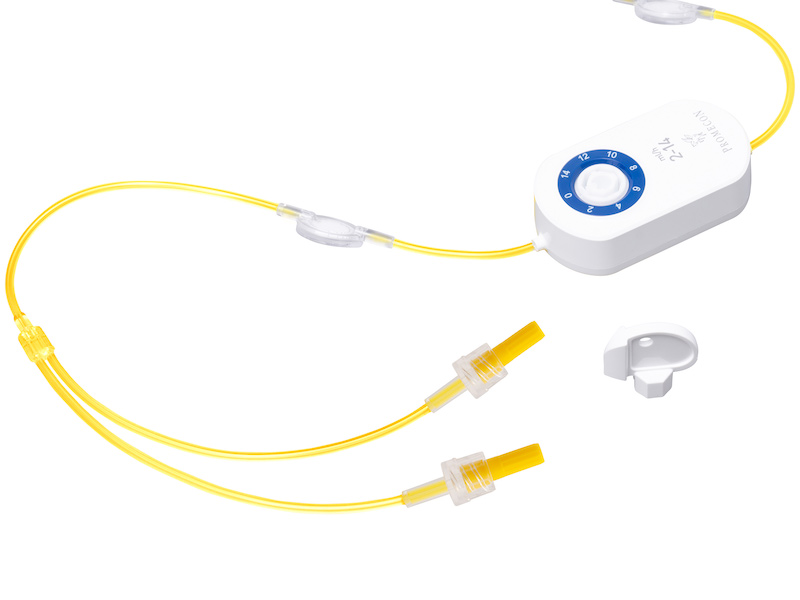
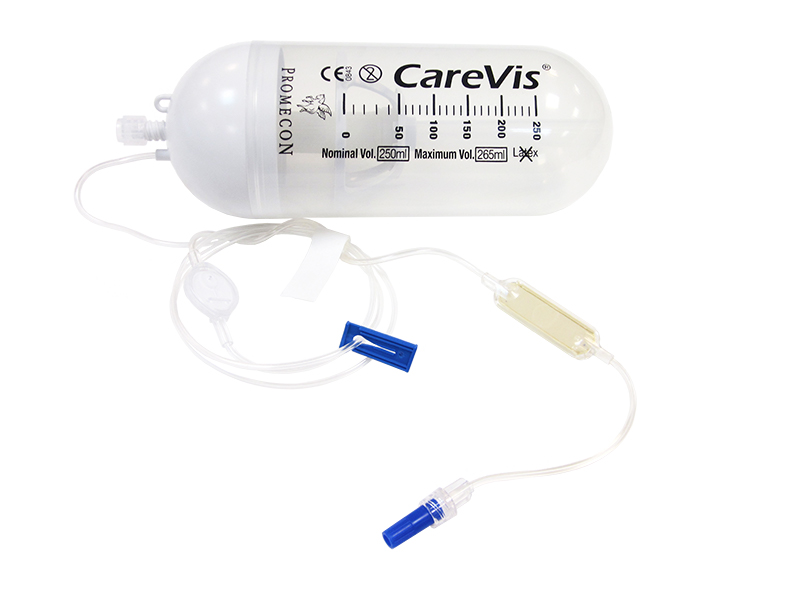
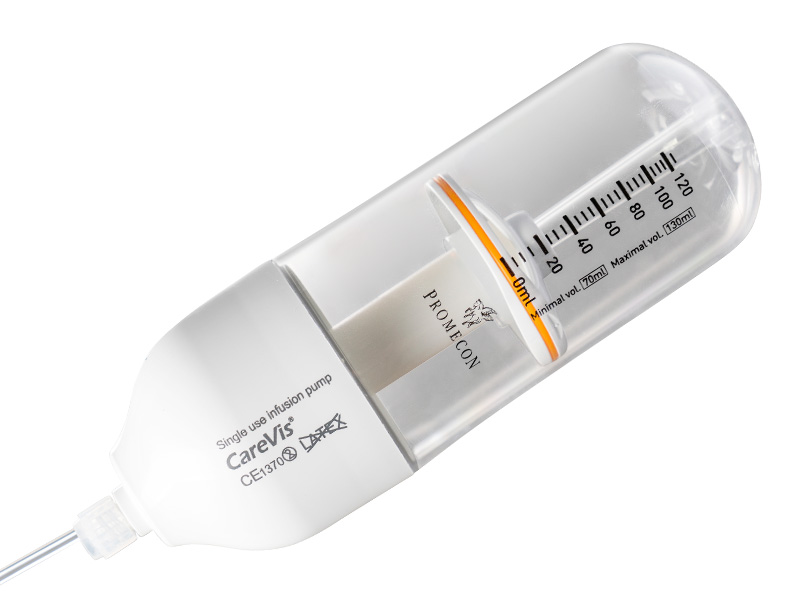
FAQ
What factors affect the flow rate of elastomeric pumps?
How reliable are the flow rate and drug delivery of elastomeric pumps?
When the pump empties, the flow rate is controlled by the physical laws. Elastomeric pumps are available with different flow rates for very slow or faster drug delivery. According to ISO standard 28620, an average flow rate deviation of +/-15% is tolerated for mechanical pumps with a fixed flow rate. As the standard only considers the average flow rate, higher deviations may be possible during infusion.
How accurate is the flow rate of CareVis elastomeric pumps?
CareVis elastomeric pumps are characterised by very precise flow rates with +/- 10% deviation and a relatively constant flow during infusion. CareVis pumps thus exceed the values required by the ISO 28620 standard. Flow rates can be influenced by external factors. These are: Filling volume, temperature, drug viscosity, height difference between pump body and distal flow restrictor as well as the catheter size used. Please follow the instructions in the instructions for use to avoid flow deviations.
How does the filling volume influence the flow rate?
You will achieve the indicated flow rate if you fill the CareVis with the nominal volume indicated in the instructions for use. Underfilling and overfilling are permitted to a certain extent, but have an influence on the flow rate. Please refer to the instructions for use for minimum and maximum allowed filling volume of your pump.
How does temperature affect the flow rate?
Temperature changes have an effect on the viscosity of medications. Therefore, for safe use of infusion pumps, temperature changes should be avoided. CareVis elastomeric pumps with continuous flow rate are calibrated to body temperature*. If the filled pump has been refrigerated, then store it at room temperature before use. Depending on volume and model, it may take 8 to 18 hours for the pump to be ready for use. *For detailed information, refer to the instructions for use.
How can I ensure that the medication maintains 32 °C?
If you are using continuous flow models, stick the restrictor to the patient's skin with a plaster or tape after connecting the pump to the patient's port. However, the plaster must not be stuck over the filter. CareVis pumps with functional units such as PCA or multirate module are calibrated to room temperature and should be protected from heat, for example from sunlight, or cold.
How much can the flow rate differ with temperature fluctuations?
A change in temperature has a directly proportional effect on the actual flow rate. The flow rate decreases or increases by approximately 2 % per 1 °C drop or increase in temperature. The temperature of the solution in the pump body is room temperature of 23 °C. The temperature of the flow limiter of purely continuous pumps such as CareVis, CareVis OncO has been calibrated at 32 °C (89.5 °F), which is the temperature when the limiter is in contact with the skin.
How does the viscosity affect the flow rate?
The nominal viscosity of the infusion solution used corresponds to that of normal saline solution (0.9% NaCl solution). A change has an indirect proportional effect on the nominal flow rate. An increase in viscosity slows down the flow rate, a decrease in viscosity increases the nominal flow rate.
How must the elastomeric pump be positioned?
The pump housing and patient connection should be placed at a level approximately in the middle of the body. Raising the pump above the distal port increases the pressure gradient and the actual flow rate. Placing it below this has the opposite effect. Holding the pump housing above the patient port acts as an additional gravity infusion.
How safe are infusion therapies with CareVis elastomeric pumps?
How do I know that the CareVis is pumping?
Depending on the therapy, it can take between hours and several days until the pump is completely empty. Therefore, the medication may run so slowly that the pumping progress can only be seen at longer time intervals. A reciprocating piston and the easily readable scale on the transparent pump housing indicate the filling level. This makes it possible to determine whether the medication is really flowing over a longer period of time.
How high is the risk of occlusion?
CareVis infusion pumps have a kink-resistant infusion line. The lumen of the line is triangular and therefore resistant to kinking and occlusion. An occlusion at the patient access would be a possible cause for a stoppage of the pump. To be sure that the infusion can be administered properly, care should be taken to ensure that the access is kink-resistant.
Can the balloon of elastomeric pumps burst?
The unbreakable, hard pump housing of the CareVis protects the balloon from external influences. Since the balloon is guided by a reciprocating piston, it cannot expand unevenly and therefore no over-expansion can occur in one place. In general, silicone balloons very rarely burst.
How safe is it to fill CareVis with cytotoxic drugs?
When filling the CareVis elastomeric pump (= priming), the infusion line fills first. A filter cap on the patient connection has a bacteria-tight forced venting which prevents liquid from dripping out. The patient connection can thus remain closed during priming and the medication cannot leak out.
What happens if the CareVis is accidentally dropped?
The housing of the CareVis elastomeric pumps is made of hard, break-proof material. This protects the balloon if the pump is dropped. The infusion can be continued as planned.
Does the CareVis provide protection against air embolisms?
All CareVis models have an inline filter with a 0.2 micron pore size bacteria-tight forced air vent. The reservoir of the elastomeric pumps has no dead space. If some air does get in when the pump is filled, it is completely removed by the inline filter with forced venting.
Is it possible for bacteria to get into the pump through the filters?
All CareVis models are equipped with a 1.2 micron inline particle filter combined with an air filter. This, as well as the venting cap on the patient connection, have a pore size of 0.2 microns and are therefore a barrier against bacteria from outside.
Can particles enter the patient's body with the medication?
According to ISO 28620, every elastomeric pump must have a particle filter. This filters particles that, for example, get into the infusion pump through the preparation of the infusion solution, out of the medication and prevents them from being administered along with it. The finer the particle filter, the more or smaller particles are filtered out of the medication and the more effective the protection.
Is CareVis also suitable for the treatment of children?
Yes. All CareVis models are suitable and safe for use on children. Please note the information in the instructions for use.
For more information on elastomeric pump safety, see our white paper.
Which infusions should CareVis elastomeric pumps not be used for?
Can CareVis be used for infusing life-sustaining medications?
No! Elastomeric pumps do not give an alarm or signal when a flow interruption occurs. Elastomeric pumps must therefore not be used for the infusion of life-sustaining drugs.
Can CareVis be used for solutions with high viscosity?
No! Solutions with high viscosity or solid particles should not be administered because they may cause slow flow or occlusion of the system. This includes blood, blood products, proteins and lipid-containing fluids.
Can CareVis be used for the administration of lipophilic drug solutions?
No. Lipophilic medication, such as those containing Cremophor, must not be used with the CareVis infusion pumps because they affect the function of the vent filters and the pump may leak as a result.
Preparation and implementation of infusions with elastomeric pumps
How should CareVis elastomeric pumps be stored?
Store the pump in a dry place and at temperatures between 4°C and 50°C. It should be protected from sunlight, especially if the pump is already filled with medication.
How long can the infusion be stored when filled?
How long the medication can be stored in the pump until administration depends essentially on the medication. A list with stability data of numerous medications can be found in the technical data sheet.
Can I administer two infusions at the same time?
For parallel infusions, a valve-proof Y-adapter should always be used to prevent the solution of the second infusion from being forced into the infusion line of the CareVis. Depending on the resistance of the access, the flow rate of the pump may be slightly slowed down.
Can the CareVis touch other liquids?
The flow restrictor, particle and air filters as well as the functional units, e.g. bolus or multirate module, can be damaged and their function affected if they get into contact with solvents such as liquids containing alcohol or soap.
Can the CareVis come into contact with water?
The pump itself, and especially the modules on the infusion line, should not get wet if possible. Simple splashes of water are insignificant.
Can I connect the CareVis directly to the patient after filling?
Make sure that the infusion line is completely vented before use. before use. Only when priming has been completed the pump may be connected to the patient. Please observe the instructions for priming in the instructions for use.
Do CareVis elastomeric pumps work with any catheter?
The length, inner diameter and position of the catheter to be used can affect the flow rate. Catheters with a small inner diameter can slow down the flow. Therefore, we do not recommend using catheters with an inner diameter of 22 or 23 gauge or thinner. Be careful not to kink the catheter.
Are elastomeric pumps reusable?
No. Elastomeric pumps are disposable. They must not be reused or resterilised. (Reuse or resterilisation may result in unpredictable infusion flow and infection of the patient).
How should CareVis be disposed of after use?
Dispose of the device at the end of infusion according to local standards for potentially toxic products..
Which CareVis elastomeric pump is used for which therapeutic areas?
For which therapies are CareVis infusion pumps suitable?
CareVis is intended for infusion of chemotherapy, antibiotic therapy, analgesic or hydration therapy and other general intravenous, intra-arterial, subcutaneous, epidural, perineural and intralesional applications.
Which CareVis is suitable for pain management?
CareVis PCA, BoluS and VariO or VariO Plus pumps are primarily designed for use in systemic or regional pain management. The corresponding NaX (with neuroaxial connector) models for use in plexus nerve blocks, the surgical wound infiltration anaesthesia or in neuroaxial epidural anaesthesia. Infusion for pain therapy includes preoperative and postoperative surgery or chronic pain.
Which infusion pump is suitable for wound infiltration anaesthesia?
CareVis and in specific cases CareVis VariO with adjustable flow rate is used in wound infiltration. The models CareVis TwiN, DuO and VariO TwiN are intended for use in surgical wound infiltration anaesthesia with two catheters.
Which infusion pump is suitable for oncology / chemotherapy?
CareVis OncO is designed for infusion chemotherapy mainly with 5-fluorouracil. The microfluidic chip of the flow restrictor in wide-channel technology prevents delays in the flow rate due to 5-FU precipitation. For other oncological infusions, the regular CareVis model with continuous flow rate is equally suitable.
Which infusion pump is suitable for antibiotic infusions?
CareVis RuN is intended for short-term antibiotic infusions with flow rates from 50ml/h to 250ml/h.
Which applications are infusion pumps with neuroaxial connector used for?
CareVis NaX are used for epidural applications of anaesthetics or analgesics, as well as for peripheral nerve blocks, mostly plexus blocks in regional anaesthesia. According to ISO 80369-6, wound infiltration anaesthesia for analgesia in surgical wounds also belongs to the applications with neuroaxial connections, although these are not procedures close to the spinal cord.
Is there a risk of confusion between Luer-Lock and neuroaxial connectors?
The patient connectors differ in colour and shape to avoid misuse when administering spinal (yellow) or venous (colourless / blue). Both connectors are not compatible with each other to ensure patient safety.
*For detailed information, please refer to the instructions for use
